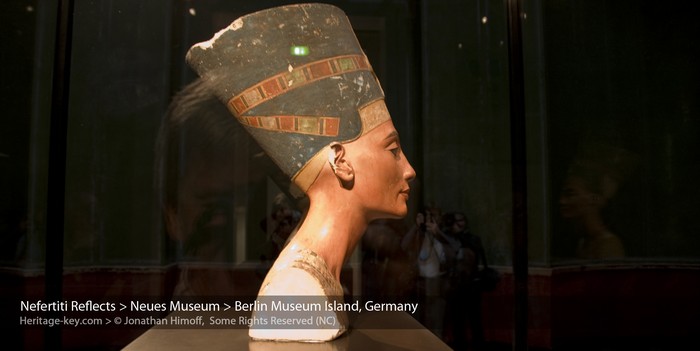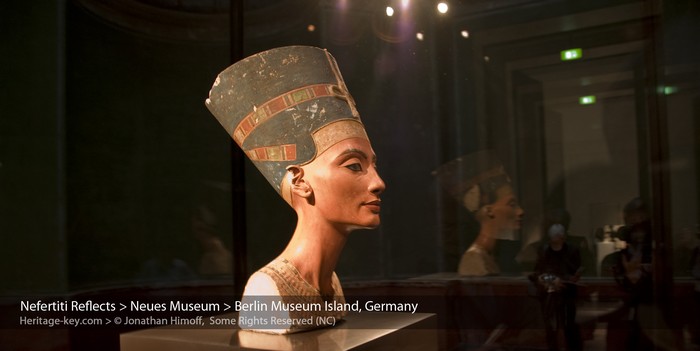 With the recent reopening of the Neues Museum on Berlin’s Museum Island, the argument over ownership of the Bust of Nefertiti has once again been stoked. The Germans have made the priceless, beautiful, 3,400-year-old sculpture of the famous Egyptian Queen one of the centerpiece attractions of the 200-million Neues. It seems to have only caused the Egyptians to become more resolute in their efforts to get her back. Secretary General of the Egyptian Supreme Council of Antiquities Zahi Hawass stated recently that he would send a letter in October to Neues Museum directors containing irrefutable evidence in support of the Egyptian claim for repatriation (no sign of that letter yet, though).
With the recent reopening of the Neues Museum on Berlin’s Museum Island, the argument over ownership of the Bust of Nefertiti has once again been stoked. The Germans have made the priceless, beautiful, 3,400-year-old sculpture of the famous Egyptian Queen one of the centerpiece attractions of the 200-million Neues. It seems to have only caused the Egyptians to become more resolute in their efforts to get her back. Secretary General of the Egyptian Supreme Council of Antiquities Zahi Hawass stated recently that he would send a letter in October to Neues Museum directors containing irrefutable evidence in support of the Egyptian claim for repatriation (no sign of that letter yet, though).
Bija recently laid out the case for why Nefertiti should remain in Berlin. Ever ones for balance here at Heritage Key, we thought it would only be appropriate to articulate the counter-argument, which is just as compelling.
Practical Arguments
Well deal with some of the practical considerations first. One of the main German arguments is that, to do an artefact of such immense beauty, worth and popularity justice, it ought to be displayed in the best possible position and conditions and surrounded by the most state-of-the-art facilities. Theres no doubting that the Neues the worlds newest museum, and one of its most expensive right now ticks every one of those boxes.
But what about a few years down the line when, in 2013, the Grand Egyptian Museum opens at Giza? Its slated to be one of the most spectacular museums ever constructed a $550 million, 100,000 square-metre cultural mecca in the shadow of the pyramids. Surely itll represent every bit as fitting a home for Nefertiti as the Neues? Its also been suggested that Nefertiti is too fragile to move, but that sounds like a bluff she wasnt teleported from her previous location at the Altes Museum to the Neues! Admittedly the two buildings are only a few metres apart, but if the technology exists to safely transport 2,250-year-old Terracotta warriors on long tours around the world, then surely it exists to take Nefertiti on a single trip from Berlin to Cairo?
 Bjia also makes the point that Egypt is already over-stocked with ancient sites and artefacts. Is there a chance that appropriate resources wont be available to maintain Nefertiti? And is there also a chance that Nefertitis magnificence could be diminished somewhat if shes surrounded by an abundance of other delights from ancient Egyptian history? Perhaps but its worth bearing in mind that first-hand access to some of Egypts greatest treasures is slowly diminishing. The Valley of the Kings most spectacular tombs, for instance, may have to close to the public altogether over the next few years, lest they become irrevocably damaged. With the long-term impact this might have on tourism in mind, the Egyptians arguably have a right to reign in their most valuable heritage prizes from abroad.
Bjia also makes the point that Egypt is already over-stocked with ancient sites and artefacts. Is there a chance that appropriate resources wont be available to maintain Nefertiti? And is there also a chance that Nefertitis magnificence could be diminished somewhat if shes surrounded by an abundance of other delights from ancient Egyptian history? Perhaps but its worth bearing in mind that first-hand access to some of Egypts greatest treasures is slowly diminishing. The Valley of the Kings most spectacular tombs, for instance, may have to close to the public altogether over the next few years, lest they become irrevocably damaged. With the long-term impact this might have on tourism in mind, the Egyptians arguably have a right to reign in their most valuable heritage prizes from abroad.
Ethical Arguments
The practical points arent really the bones of this debate as with all disputes over artefact repatriation, its chiefly an ethical argument. In this respect, the Egyptians are comfortably in the right. German Egyptologist Ludwig Borchardt tricked the Bust of Nefertiti out of Egypt sometime between 1911 and 1914 in a subterfuge violating statutes of the period and of the present.
He excluded mention of the bust from his published list of discoveries made during excavations in Egypt; when he did finally provide descriptions of the artefact, he lied about its quality and condition, making it out to be a worthless piece of gypsum and producing a photograph of the bust that cast it in a deliberately unflattering light. All the while, he clearly knew how valuable the bust was. It is indescribable, he recorded in his personal diary. You have to see it with your own eyes.
Isnt there a degree of shame on behalf of the Germans that one of their most-prized archaeological possessions was obtained so disreputably? Couldnt and shouldnt this very clear wrong be righted in the 21st century?
Its more complicated than that of course. Giving back the Bust of Nefertiti is the sort of move that could pull the proverbial rug out from under the feet of the likes of the British Museum who refuse to permanently repatriate the Elgin Marbles to Greece and the Rosetta Stone to Egypt. Its as if theres an unspoken agreement between museums not to budge when it comes to artefact repatriation, lest Pandoras Box be opened.
But maybe these claims and counter-claims are all somehow relative? If the Neues Museum was to relinquish Nefertiti, surely it would strengthen immeasurably its own case for the return from Russia of artefacts plundered by the Soviets at the end of WWII, such as Priams Treasure?
A Compromise?
As proven by the recent example of the SCA blocking French excavations at Saqqara until the Louvre agreed to return stolen fragments from a Theban tomb and they promptly did Zahi Hawass and the Egyptians arent scared to play hard-ball when it comes to regaining artefacts. But theres a more reasonable way for this and similar arguments to be resolved. Loan systems such as the one recently agreed between the National Museum of Scotland and the British Museum over the Lewis Chessmen can take the sting out of such debates, and establish a strong platform of negotiation upon which to build towards a permanent solution.
The Germans have expressed fears that if they loan the Bust of Nefertiti to Cairo, like a pinched library book, itll never come back. Judging by the humorous tone of comments from Zahi Hawass, quoted recently in The Times, the prospect of the Egyptians committing grand international artefact larceny in full glare of the worlds media seems faintly ridiculous. They think that we will be like the Raiders of the Lost Ark, he joked. That we will take it and not return it.
Money talks of course, and no museum is going to willingly accept the financial hit that comes with giving up an artefact capable of drawing 500,000 visitors per year, as Nefertiti did at her former home the Altes Museum. Yet, if that gap could be plugged, then maybe money can be taken out of the equation to some extent. The Egyptians could offer a loan artefact (or artefacts) in return theyve got plenty of them.
Logistical considerations aside, perhaps all major museums need to be less precious with their prize possessions, and accept that by sending them out on loan, while in turn accepting others from elsewhere, they can avoid time-consuming, reputation-damaging arguments, and at the same time constantly refresh their appeal. Touring exhibits can be hugely successful King Tut exhibitions worldwide have drawn in millions of visitors on their travels around the world since the 1970s, while more recently the Terracotta Warriors too have proven wildly successful.
As Bija mentioned, Nefertiti has a certain unquantifiable power over those who possess her, and the prospect of giving her up may be a simple matter of wounded pride as much as anything else. Yet, if a reasonable and rational compromise based on loans could be agreed, neither the Germans not the Egyptians need come away from this dispute having lost face. If future loan arrangements with other museums elsewhere could be agreed too, the wonder of the Bust of Nefertiti could be spread around the world for others to enjoy as well. Everyones a winner.
Not convinced? Read Bija’s opposing blogpost on why Nefertiti should remain in Berlin.





